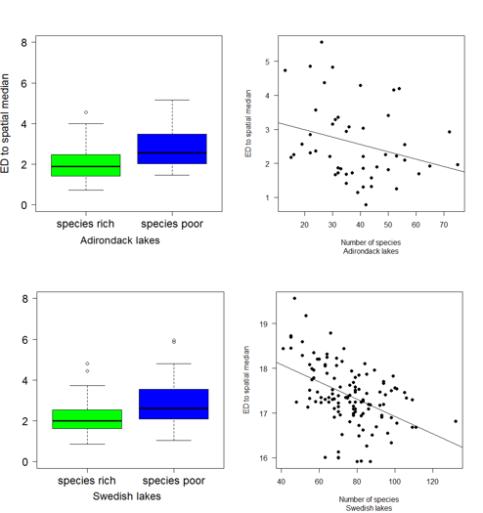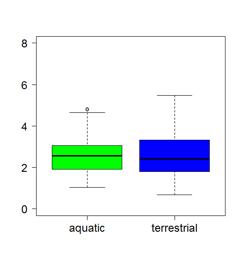Species richness

There were large differences in diversity of ecosystem structures between the species rich and poor ecosystems. Linear regressions also showed clear relationships between the number of species of an ecosystem and its dissimilarity from the average network structure. There has been a debate whether species richness would increase or decrease stability of ecosystems. This could potentially be linked to ecosystem structure. If it is true that an increasing number of species would destabilize the ecosystem, it could be that the number of possible stable network structures also decreases. That there are more possible stable ecosystem structures for species poor food webs than fo species rich. This could manifest as the larger dispersion of network structures observed for the species poor ecosystems. As species richness increases, more ecosystems would be structured similar to the average stable structure.
As food web network structure is linked to ecosystem functioning it is possible that there is a larger variety of ecosystem functions and services among smaller lakes than larger ones. Different topological structures could also mean that ecosystems respond differently to disturbances. One type of network structure might make the ecosystem resilient against invading species while another might decrease the risks of secondary extinctions after a species loss. Following this line of thoughts, it might be worthwhile to consider the SLOSS debate. It could be that an area containing several small and species poor lakes might provide a wider array of ecosystem services, as well as a higher response diversity to disturbances, due to a larger diversity of network structures than it would with fewer larger and species rich lakes.
Aquatic and terrestrial ecosystems

There was no significant difference in network structure variation between the aquatic and the terrestrial group. While the aquatic group displayed a slightly higher mean distance to the spatial median, the terrestrial group had a larger variation including both the shortest and longest distances. It is possible that the lack of significant results stems from the imprecise groupings. The aquatic group contained rivers, lakes and marine food webs while the terrestrial group contained e.g. forests, deserts and swamps. It is possible that these course groupings led to large within-group variation that obfuscated differences between the groups. With a larger quantity of food webs, it would be better to compare more refined groups, such as comparing the diversity of lake and stream food webs
Responsible for this page:
Director of undergraduate studies Biology
Last updated:
06/09/16
